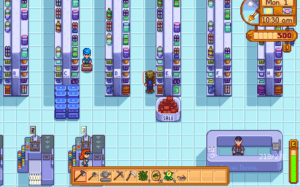Stardew Valley
Stardew Valley was developed by indie game designer Eric Barone under his alias ConcernedApe. The game offers a farming simulation experience on various platforms though I personally purchased it from Steam. The target audience of Stardew Valley is relatively broad, encompassing fans of farming simulation games, indie game enthusiasts, or players seeking an escape from the stresses of everyday life.

Formal Elements, Types of Fun, & Feminist Theory
- Avatar Customization + Gender: As a part of the onboarding process, players must customize their avatar by choosing their gender and appearance (hair, outfit, etc.), allowing for expression. Although Stardew Valley’s avatar customization options are more inclusive than most with 24 skin tones and 73 hairstyles, there is still an issue with gender representation. Players must choose between man or woman for their avatar’s identity, and their avatar’s physical appearance alters depending on which gender the player chooses. This can be problematic in enforcing stereotypes of what a man or woman should look like.
- Lack of Racial Diversity: While Stardew Valley offers an inclusive range of skin tones during avatar customization, the majority of the featured characters in the game possess a white or Eurocentric appearance. This can be interpreted as a missed opportunity for representing racial or ethnic diversity, and it can be alienating for players with darker skin tones to be in a town of mostly characters with lighter skin tones.
- Breaking Gender Roles: As a woman taking the role of a female avatar that explores, farms, mines, fishes, and combats monsters, I appreciate how the game challenges traditional gender roles. Regardless of gender, all players can complete activities without any inherent limitations. Stardew Valley is a world of discovery that breaks away from the traditional association of certain activities with certain genders. Furthermore, I find it awesome that many of the featured characters defy gender norms and stereotypes. There are female characters who excel at combat and mining, and there are male characters who have more artistic inclinations.
- Diverse Relationships: As players build relationships with the other characters in town, they have the opportunity to form friendships or romantic relationships with characters of various genders. Players can date people of the same gender or date multiple people at the same time. In supporting all types of relationships, Stardew Valley promotes inclusivity and LGBTQ+ representation.
Improvements Utilizing Feminist Perspectives
As I previously discussed, Stardew Valley can benefit by expanding their character roster to include a wider range of racial and ethnic backgrounds. Perhaps this can even be taken a step further and provide even greater inclusion if the characters also possessed LGBTQ+, disabled, or marginalized perspectives. I believe the incorporation of intersectional representation can not only enhance inclusivity but also make the NPCs feel more complex and therefore more human and easier to relate to. I personally find the narrative about transitioning from Joja Corporation to Stardew Valley especially interesting, and I think the narrative provides an opportunity to more deeply explore power dynamics such as economic disparities associated with capitalist society.

Conclusion
Overall, I am a huge fan of Stardew Valley. With its earthy tones and warm atmosphere, this game is the perfect escape from reality and all the stresses that come with being a Stanford student in the Silicon Valley. Stardew Valley helps me dream of another life where things are simpler.
Discussion Question
Intersectionality is a key aspect of feminist theory. How can games address the intersectional experiences of individuals based on factors such as race, ethnicity, sexuality, and disability?




